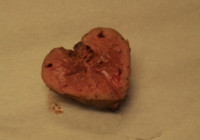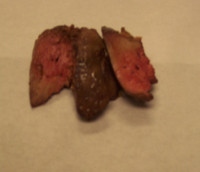Safe cooking of livers
What is the issue?
Unlike whole pieces of red meat such as steak or chops where microbial contamination is restricted to the external surfaces, livers can be contaminated with Campylobacter on both the inside tissues and the outer surfaces. Levels of Campylobacter organisms on poultry meats are higher than on other meats but recently outbreaks have been traced to lambs liver, often called lambs fry. To ensure that cooked livers are safe for eating, appropriate controls are needed to reduce the risk of infection, without spoiling the quality of the product.
What can go wrong?
Outbreaks of campylobacteriosis have occurred as a result of restaurants serving under cooked livers. Products included sliced or whole lamb and chicken livers and chicken liver mousse or pâté.
Examples of control breakdowns have included:
- Undercooking of livers, allowing bacteria to survive (see Figure 1). There is a belief that livers will become dry and unpalatable if cooked too long.
- Poor separation, allowing cross contamination from raw livers to cooked product.
- Poor sanitation, allowing re-contamination of cooked product by bacteria from hands, knives and unclean surfaces.
How can I tell if product is contaminated?
New Zealand studies have shown that livers are frequently naturally contaminated by Campylobacter on external surfaces and internal tissues. This contamination will not adversely affect the look or smell of livers.
What can I do to protect the consumer?
- Sauté livers in small batches to allow for effective cooking
- Sauté livers for at least 5 minutes or until an internal temperature of >70°C has been reached and maintained for 2-3 minutes.
- Use a food thermometer to check the internal temperature of the largest liver in the batch.
- Livers should be cooked until they are no longer bloody in the core. Colour is not a reliable indicator of effective cooking. Studies have shown that liver tissue can remain pink after it has reached a safe temperature (see Figure 2).
- Ensure juice from uncooked livers does not leak onto other foods.
- Scrub cutting boards, knives and other utensils that have come in contact with raw livers using hot water and detergent and allow them to dry.
- Preferably use a separate board and utensils for preparing poultry.
- Prepare pâté by using a two stage cooking process, sauté livers in a pan and complete the cooking in a water bath at sufficient time and temperature to reach an internal temperature to kill Campylobacter.


